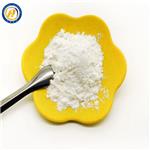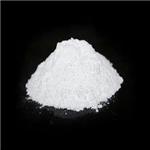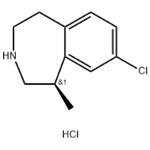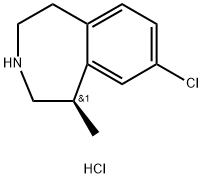Application and Pharmacology of Lorcaserin hydrochloride
Dec 7,2021
General description
Lorcaserin hydrochloride is a hydrochloride obtained by reaction of lorcaserin with one equivalent of hydrochloric acid. Used as an anti-obesity drug. It has a role as a serotonergic agonist and an appetite depressant. It contains a lorcaserin(1+). Lorcaserin hydrochloride is a DEA Schedule IV controlled substance. Substances in the DEA Schedule IV have a low potential for abuse relative to substances in Schedule Lorcaserin Hydrochloride is chemically (R)-8-Chloro-1-methyl-2,3,4,5-tetrahydro-1H-3-benzazepine hydrochloride. Lorcaserin HCl is a novel, synthetic, centrally-acting selective serotonin C (5-HT2c) receptor, l agonist, which results in increased satiety and decreased food consumption in patients. [1,2]
Application and Pharmacology
Current treatment options for the management of obesity consist of several therapeutic agents like norepinephrine inhibitors, serotonin reuptake inhibitors, pancreatic lipase inhibitors, thermogenesis stimulators (β3 AR agonist), and cannabinoid receptor 1 antagonist. As these agents were found to possess some severe side effects so efforts were undertaken to find a new agent that will give a comparable or boosted effect than the existing ones with considerably fewer side effects[3]:
A new moiety has been discovered as an appetite suppressant (anorectic) called Lorcaserin HCl and it has been found to be effective because of its 7.5 and 11.6 fold selective action on the 5HT2C receptor than 5HT2A and 5HT2B receptors in humans, respectively, thus, side effects associated with 5HT2A and 5HT2B agonists were overcome and so this drug is now used for long-term therapy in the management of obesity with a blend of some modification in lifestyle, food habits and exercise. Lorcaserin HCl has two major metabolites,
one conjugated with glucuronide called N-carbamoyl glucuronide which is excreted in urine and the second Lorcaserin N-sulfamate, which is circulated in the blood. Lorcaserin HCl is synthesized using four different schemes of which a six-step method that resulted in 92.3% yield with 99.8% of purity is employed for scale-up production[3].
The potential therapeutic applications of lorcaserin are expanding beyond obesity and T2DM. Emerging evidence suggests benefits independent of weight loss in nonalcoholic fatty liver disease (NAFLD). Furthermore, lorcaserin’s dampening effect on the mesocorticolimbic system supports its use in patients with schizophrenia], binge eating disorder, and substance abuse disorder. Beyond obesity treatment, lorcaserin may adopt further applications in T2DM, NAFLD, and diseases of dopaminergic dysfunction.
Synthesis
There are various precursors and routes to the synthesis of Lorcaserin hydrochloride (Fig. 1). In the scheme, three major precursors are shown which resulted in a common intermediate and finally led to the formation of Lorcaserin hydrochloride with the help of a variety of reagents and different reaction mechanisms. As mentioned in the table, there were some limitations with each method and only a six-step method with 2-(4-chlorophenyl) Ethan-1-amine as a starting product was able to give a yield of around 92.3% with 99.8% purity and all the disadvantages of other methods were overcome. The six steps that were employed for the synthesis of Lorcaserin hydrochloride include as shown in Synthetic route I(C):
1) N-protection of 2-(4-chlorophenyl) ethanamine
2) N-alkylation
3) Deprotection
4) Intramolecular Friedel-Crafts alkylation
5) Chiral resolution
6) Final salification
The different routes of synthesis of Lorcaserin Hydrochloride required a number of steps and use of some hazardous and toxic solvents and reagents (DMA, SOCl2, PBr3, HBr or BH3, etc.
Insight into synthesized only two steps process was successfully done for Lorcaserin by J. Cluzeau, G. Stavber[4]. Efficient and economic process was successfully developed for lorcaserin. This synthetic route gives access to racemic lorcaserin and involves 2 simple chemical steps from commercially available routine starting materials to racemic lorcaserin followed by diastereomeric crystallization provide optical pure target API (purity > 99.8%). Insight into the crucial synthesis step - a Friedel-Craft reaction of an allyl ammonium chloride salt in the presence of aluminum or zinc chloride under neat conditions – were gathered. This reports a more sustainable and economic process in the fina loptical resolution stage by developing an efficient racemization technology. This led to a more economical overall process by significantly lowering the raw material cost in comparison to the best known prior art.
A two-step process to synthesize racemic lorcaserin was developed from 2-(4-chlorophenyl)ethanol via formation of bromide or tosylate derivatives. These derivatives were reacted with allylamine in neat conditions to provide pure N-(4-chlorophenethyl) allylammonium chloride. This compound was cyclized in neat conditions using aluminum or zinc chloride to give racemic lorcaserin. After resolution of enantiomers, the wrong enantiomer was racemized and recycled to give new Rlorcaserin[4].
History
A few years ago (2012), Lorcaserin was approved for the treatment of obesity which is a conformationally restricted analog of dexfenfluramine that produces selective agonistic action with fewer side effects. In general, oral lorcaserin is well tolerated in clinical studies, with hypoglycaemia and headache the most frequently reported adverse events in those with or without type 2 diabetes, respectively. Formerly known as APD-365, it is a novel selective 5-HT receptor agonist. Lorcaserin was approved by the FDA in 2012 as an adjunct to lifestyle changes for chronic weight management in adults with BMI≥30 kg/m2or BMI≥27 kg/m2with at least one weight-related comorbidity.
Toxicity
Lorcaserin is a selective agonist at the 5HT2C receptor (5HT2CR) with a relatively weak binding affinity to 1A and 2B receptors at the recommended dose. In activating 5HT2CR expressed on pro-opiomelanocortin (POMC) and cocaine-and-amphetamine-regulated transcript (CART) neurons in the hypothalamus, lorcaserin is thought to stimulate the production of anorexigenic peptides POMC and CARTHeadache, dizziness and nausea are the most common side effects associated with this drug.
It is delineated as a Schedule IV controlled substance because supratherapeutic doses of oral lorcaserin (40 and 60 mg) produced measures of euphoria and hallucinations in recreational drug users similar to positive controls zolpidem and ketamine. However, in clinical studies of participants with obesity treated for 4 weeks to 2 years, the incidence of euphoria and hallucinations following doses of lorcaserin up to 40 mg was less than 1%. Short-term studies evaluating its abuse potential within 24 h demonstrated the negative effects of supratherapeutic doses starting at 40 mg. The efficacy and safety of lorcaserin in the treatment of obesity have been well established in four RCTs. In combination with lifestyle modification, lorcaserin induced an average placebo-subtracted weight loss of ~3% with clinically significant improvements in glycemic parameters independent of weight loss.
Reference
1.Tchang B. G., Abel B. & Zecca C. et al., "An up-to-date evaluation of lorcaserin hydrochloride for the treatment of obesity," Expert opinion on pharmacotherapy, Vol.21, No.1(2020), pp.21-28.
2.Woloshin S. & Schwartz L. M., "The new weight-loss drugs, lorcaserin and phentermine-topiramate: slim pickings?" JAMA Intern Med, Vol.174, No.4(2014), pp.615-619.
3.Sharma S., Aware K. S. & Hatware K. et al., "Chemistry, Analysis, Pharmacokinetics and Pharmacodynamics Aspects of Lorcaserin, a Selective Serotonin 5-HT2C Receptor Agonist: An Update," Mini Rev Med Chem, Vol.20, No.9(2020), pp.768-778.
4.Cluzeau J. & Stavber G., "Development and optimization of a new synthetic process for lorcaserin," Bioorganic & Medicinal Chemistry, Vol.26, No.4(2018), pp.977-983.
- Related articles
- Related Qustion
Edoxaban is an orally active inhibitor of coagulation factor Xa (activated factor X) with anticoagulant activity. Edoxaban is administered as Edoxaban tosylate.....
Dec 7,2021DrugsNADP disodium salt (Disodium NADP), a nicotinamide adenine dinucleotide, is a redox cofactor. NADP disodium salt is a key cofactor for electron transfer in the metabolism, being alternately oxidized (NADP+) and reduced (NADPH).....
Dec 7,2021Biochemical EngineeringLorcaserin hydrochloride
846589-98-8You may like
Lorcaserin hydrochloride manufacturers
- Lorcaserin hydrochloride
-

- $0.00 / 1kg
- 2024-04-29
- CAS:846589-98-8
- Min. Order: 1kg
- Purity: 99%
- Supply Ability: 500
- Lorcaserin hydrochloride
-

- $30.00 / 1KG
- 2024-01-02
- CAS:846589-98-8
- Min. Order: 1KG
- Purity: 0.99
- Supply Ability: 20 tons
- (R)Lorcaserin hydrochloride
-

- $0.00 / 1kg
- 2023-11-01
- CAS:846589-98-8
- Min. Order: 1kg
- Purity: 99%
- Supply Ability: 10tons




